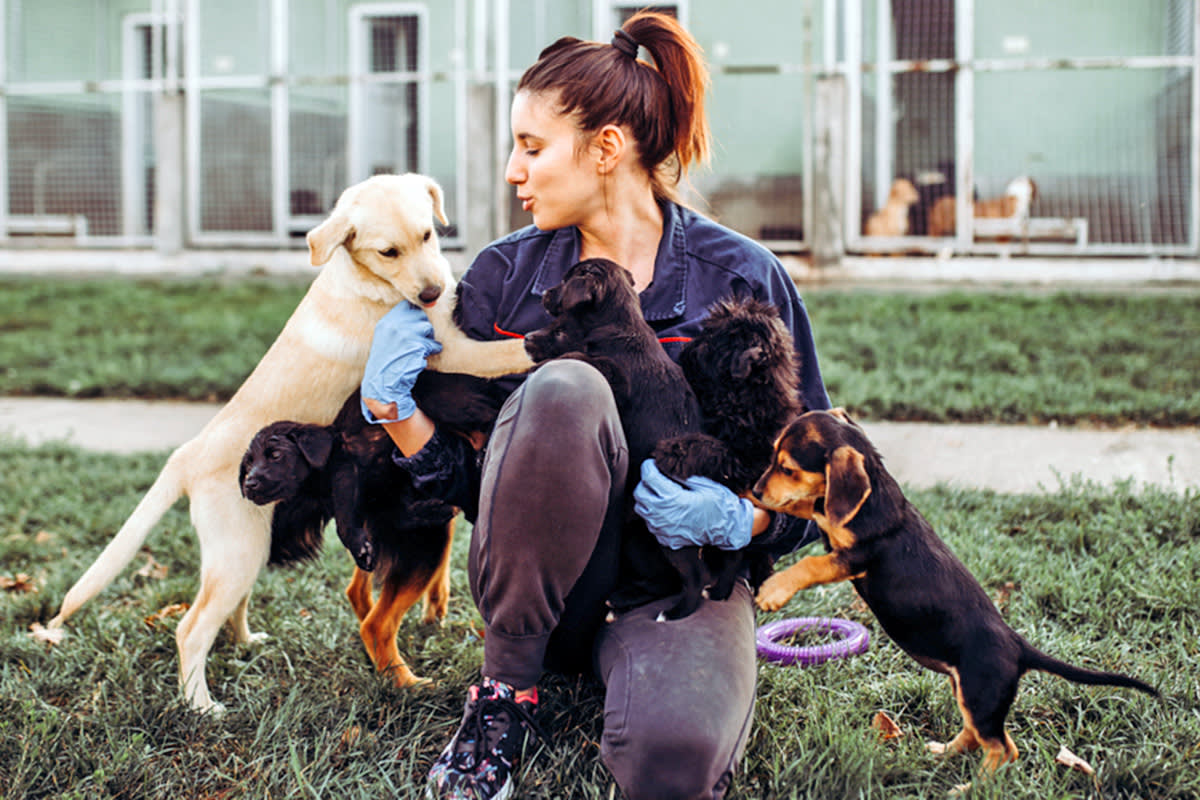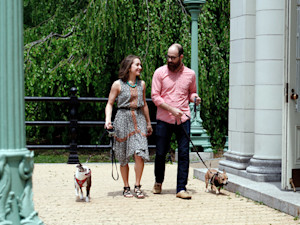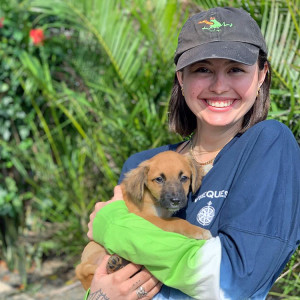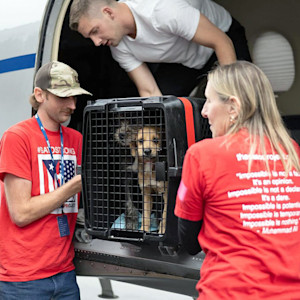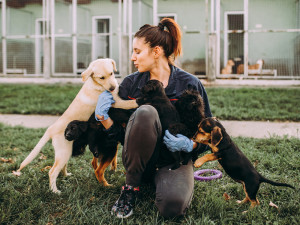The Truth About Kill Shelters—and Why They Need Your Help
Two experts discuss the real challenges these facilities face—and how to fix a broken system.
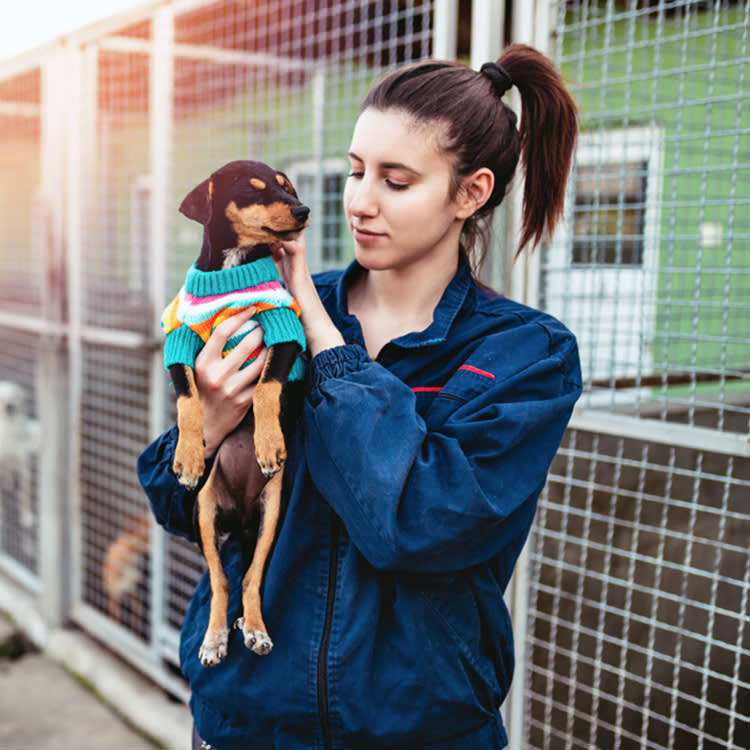
Share Article
The thought of an animal in a shelter has always broken my heart. When I was little, the “dog pound” scene in Lady and the Tramp tore me up, and I couldn’t look at the “shelter animal of the week” in our neighborhood newspaper (this was pre-internet) without feeling a big old punch to the gut. It often sent me into a crying spiral. By the time I was in college, I was a staunch advocate for the no-kill movement.
I felt so sad about the plight of dogs in regular shelters that one day, as a broke 19-year-old college student, I showed up at the kill shelter in my university town and told them to give me the dog who had the least amount of time left. She was a young tri-color Shepherd / Collie mix I named Zooey. I didn’t understand why every shelter couldn’t have a no-kill policy. Did people want pets like Zooey to die?
To me, kill shelters — which are also known as “open-admission shelters” because they typically do not refuse any animal — were a depressing place where depressing things happened. (Many shelters that practice euthanasia may consider themselves “no-kill” if they manage to save 90 percent of the animals, while I personally would still classify that as a “kill” shelter.) Outside of adopting Zooey and our family dog, Brandy, from an open-admissions shelter, I tried not to think about them because it was too hard to bear witness to what animals go through there.
What I did not realize is that by looking away, I was part of the problem: If kill shelters scared me, I wondered how terrified the animals must feel. And even if not every animal can be saved, wouldn’t it be better to do what I could to help and offer companionship?

These days, I’m actually a volunteer in a New York City open-admissions shelter, and I know the realities of our shelter and shelters like mine across the United States. What I have seen volunteering here guts me: I know that not all animals make it (and to their credit, my shelter’s wonderful volunteer coordinators are very transparent about this during orientation). Sometimes, there aren’t enough supplies, and the volunteer group chat erupts in questions about why we can’t find Timothy hay for the rabbits. Often, the hallways are lined with dog crates with inquisitive faces looking up as you pass — there is literally nowhere else to put them. So, a lot of days there can feel pretty bleak.
In a small bit of good news, last week New York Gov. Kathy Hochul announced opens in new tab that she would be giving $10 million to New York State Companion Animal Capital Projects Fund, a state-funded program that supports animal shelter improvement projects. But as amazing as that is, I know even that grand sum won’t make a big enough dent for New York City animals. Bigger shifts need to happen to improve the overall system.
I decided to chat with Kristen Hassenopens in new tab, the founder and CEO of Outcomes Consultingopens in new tab, who has made it her mission to create change in U.S. shelters and place more animals in permanent homes. I wanted to learn how we can change perceptions of open-admissions shelters so that more people adopt and dedicate their time, what challenges the shelters face right now, and whether we’ll ever see a no-kill world.
This interview has been edited for brevity and clarity.
You’ve been working with shelters since 1999. Can you explain what you do?
Kristen Hassen: I’ve run several [open-admission shelters], and now I work with some of the biggest shelters in the country, trying to just mitigate the harm of the mass intakes and animals sitting in cages where the available staffing doesn’t come close to matching what is needed for these animals.
What’s the biggest change you’ve seen in recent years?
The thing that I think has changed is shelters are trying to keep more animals alive for longer, but adoptions are really sluggish, particularly for dogs. We’ve seen really overcrowded shelters housing too many animals, like I work with Riverside [County Department of Animal Services in California], which has an intake of about 35,000 [animals] a year in a place where not that many people live.
How do you navigate a situation like that when it feels so overwhelming?
I did that in L.A., at Los Angeles Animal Services. You’ll have dogs sitting there that are good dogs, but they’ve been there, like, a year. You look, and you’re like, “What’s the last time somebody marketed this dog?” And you’ll see it’s been eight months. “And when’s the last time they’ve been out of a kennel?” [And you’re told], “Oh, it’s been a really long time.” That problem is only solved with a massive number of volunteers, fosters, and community members showing up to help.
I get why people are so critical of open-admissions shelters, but seeing the view from inside the shelter, sometimes there is literally no space, and I worry that the hate I see online scares away potential volunteers and adopters.
It’s frustrating, because I’m more critical of the shelter workers and leaders. I think they could do better. Like, you walk in a shelter now, they’re totally full, and you’ll have a shelter worker be like, “Oh yeah, no, nobody can help you see that dog right now.” I see this every single day. Someone is either ignored, turned away, told they can’t adopt, told that animal’s not available.
We’re a big part of the problem. I was trying to get a dog out to a rescue, and he was a euth-listed dog, and it took me about six hours, four phone calls, because I ran into roadblocks. I had to call the director of the shelter to get the dog out. They are so bogged down in red tape and rules and fear of risk. It’s not an individual person's fault, but the system is really broken right now.
As a volunteer, I see that there is literally no money for certain things. Like, if the washing machine breaks down, the shelter has to ask the public to bring in fresh linens for animals to sleep on until it’s fixed.
This gets into the bigger problem, which no one wants to talk about, but [for] virtually every other institution — from schools to libraries to community centers and parks — there’s state and federal funding available to support those. We don’t have any in animal welfare, so we’re totally reliant on that locality’s interest in paying for animal services. Shelters are not funded for the work they’re expected to do these days.
How can some shelters call themselves no-kill when they euthanize?
We don’t have national data collection, so anyone could say they were no-kill. I would be working with shelters where they would have a reported live release rate of 92 percent, but their real release rate would be 65 percent.
You can be like, “Oh, we have 90 percent because we exclude every animal that was surrendered because it was sick.” Shelters manipulate the hell out of those numbers. But the second problem [is the stigmatization of] frontline shelter workers, who are often working-class, people of color, people that don’t have opportunities to move up to other jobs. And so the people having to do the killing are already marginalized people, and so then we’re calling them killers.
And right now, we have immigrants forced to give up their pets. This is so sad, because what’s happening in shelters is reflective of society.
Yeah, exactly. I’m here in Ventura [California], where it’s a heavy agriculture area with tons of undocumented folks, working, toiling in fields all day, and then having ICE show up. So many of them have animals, and we have these beloved animals just showing up randomly in our shelters.opens in new tab I feel a little hopeless some days. But I do know that what works is to throw open your doors and invite everyone to come in, because for animals, being seen is being saved.
Do you see a world where we can end euthanasia completely?
I see a world in which we make foster care the primary housing solution for the majority of homeless pets. I see a world in which we have really taken seriously the idea that fosters and volunteers can change the world.
How else can volunteers can make the biggest difference in this moment?
Volunteers should be working in every single part of every shelter. I had volunteers helping with euthanasia. If we had to euthanize a dog, the volunteers knew, they would be there. [The dog] would have yard time, everybody would hang out with them, they’d get hamburger, whatever they wanted, and then the volunteers would be with them at end of life. And the rule was, you know, you can’t cry on them.
You have to give them a joyful ending. I still get teary when I think about what that meant for those animals, to not be alone in a cold room, but to be surrounded by love. That’s how we should be thinking about this: How can we surround these animals with as much love as possible?
Could we think about every animal as having value and deserving some basic standards of love and care? And if we did, what could we do differently? And that’s going to take volunteers.

Marti Trgovich
Marti Trgovich is a writer specializing in pets and wildlife. She has written about animals for National Geographic, The Washington Post, Newsweek, and other publications, and she spent nearly a decade as an editor at The Dodo. Her favorite animals are guinea pigs, sheep, and small, saucy senior dogs.
Related articles
![Couple walks their dogs on a date outside at the park.]()
These Volunteer Programs Let You Take Shelter Dogs Out for an Adventure
Whether you’re going for just a stroll or an all-day hike, everyone will benefit big time.
![Woman volunteering and holding dog.]()
How to Turn Your Vacation Into an Opportunity to Help Local Rescue Animals
Split your time sipping cocktails by the beach and being a “voluntourist” for puppies and kittens in need.
![a dog in a crate being carried onto a plane by volunteers]()
Want to Help a Rescue Pet Get to Their New Home? Become a Transport Volunteer
Domestic and international transport volunteers are in high demand—here’s how you can become one.
![Happy Labrador Retriever sitting on the floor]()
Did You Know 25% of Shelter Dogs Are Purebred?
If your heart is set on a purebred pup, start your search at breed-specific rescue organizations.
![A couple laying on their couch in a cozy looking living room with their large mixed breed foster dog]()
How to Discover the Joys of Dog Fostering
Every dog needs a forever home, fostering helps dogs to find one.
![Woman holding dogs at an animal shelter]()
10 Ways Animal Shelters Are Upping Their Game
New trends we can totally get behind.

